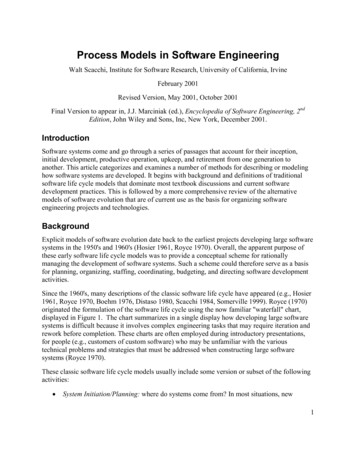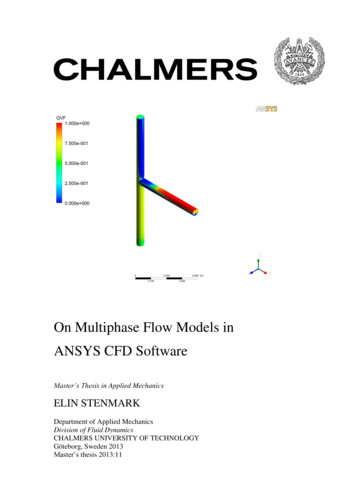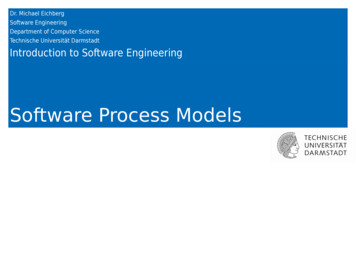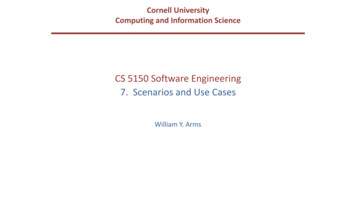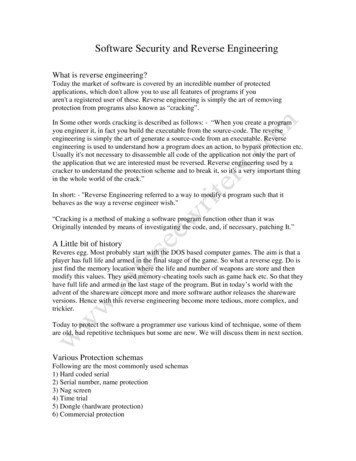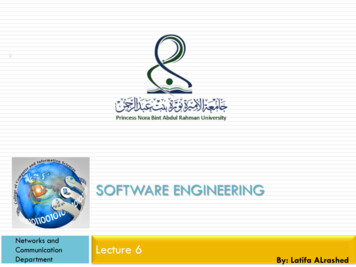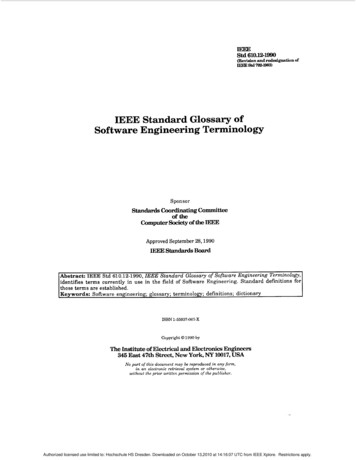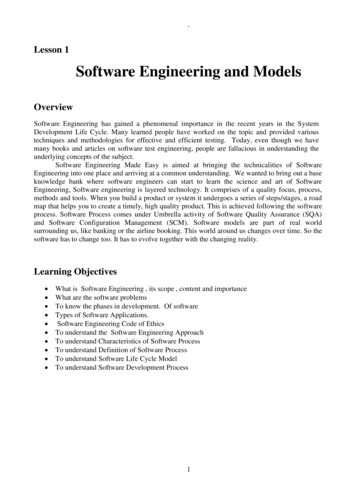
Transcription
.Lesson 1Software Engineering and ModelsOverviewSoftware Engineering has gained a phenomenal importance in the recent years in the SystemDevelopment Life Cycle. Many learned people have worked on the topic and provided varioustechniques and methodologies for effective and efficient testing. Today, even though we havemany books and articles on software test engineering, people are fallacious in understanding theunderlying concepts of the subject.Software Engineering Made Easy is aimed at bringing the technicalities of SoftwareEngineering into one place and arriving at a common understanding. We wanted to bring out a baseknowledge bank where software engineers can start to learn the science and art of SoftwareEngineering, Software engineering is layered technology. It comprises of a quality focus, process,methods and tools. When you build a product or system it undergoes a series of steps/stages, a roadmap that helps you to create a timely, high quality product. This is achieved following the softwareprocess. Software Process comes under Umbrella activity of Software Quality Assurance (SQA)and Software Configuration Management (SCM). Software models are part of real worldsurrounding us, like banking or the airline booking. This world around us changes over time. So thesoftware has to change too. It has to evolve together with the changing reality.Learning ObjectivesWhat is Software Engineering , its scope , content and importanceWhat are the software problemsTo know the phases in development. Of softwareTypes of Software Applications.Software Engineering Code of EthicsTo understand the Software Engineering ApproachTo understand Characteristics of Software ProcessTo understand Definition of Software ProcessTo understand Software Life Cycle ModelTo understand Software Development Process1
.Introduction―Knowledge is of two kinds: we know a subject ourselves, or we know where we can findinformation upon it.‖-Samuel JohnsonSoftware is playing an increasingly important and central role in all aspects of daily life—ingovernment, banking and finance, teaching, transportation, entertainment, medication, farming, andlaw. The number, size, and application domains of programs being developed have growndramatically; as a result, billions of dollars are being spent on software development, and thelivelihood and lives of millions directly depend on the effectiveness of this development.Unfortunately, there are severe problems in the cost, timeliness, and quality of many softwareproducts; even more serious is the effect that quality problems can have on the safety-criticalelements of software that directly affect the health and welfare of humans.What is Software Engineering and Why is it Important?In various texts on this topic, one encounters a definition of the term software engineering.Software Engineering defined in the first NATO conference as (Definition by Fritz Bauer―Software engineering is the establishment use of the sound engineering principles in order toobtain economically software i.e. reliable and works efficiently on real machines.‖IEEE standard Definition of Software EngineeringSoftware engineering is application of systematic, disciplined, quantifiable approach todevelopment, operation and maintenance of software i.e. application of engineering to software.Importance of software engineeringSoftware engineering is an engineering approach for software development. We can alternatively view itas a systematic collection of past experience. The experience is arranged in the form of methodologiesand guidelines. A small program can be written not including using software engineering principles. Butif one wants to develop a huge software product, then software engineering principles are crucial toachieve a excellent quality software cost effectively. These definitions can be elaborated with the helpof a building construction analogy.Suppose you have a companion who asked you to build a small wall as shown in fig. 1.1. You would beable to do that using your common sense. You will get building materials like bricks; cement etc. andyou will then build the wall.Fig. 1.1: A Small WallBut what would happen if the same friend asked you to build a large multi-storeyed building as shownin fig. 1.2Fig. 1.2: A Multi-storeyed Building2
.You don't have a very good idea about building such a huge complex. It would be very difficult toextend your idea about a small wall construction into constructing a large building. Even if you tried tobuild a large building, it would collapse because you would not have the requisite knowledge about thepower of resources, testing, planning, architectural design, etc. Building a small wall and building alarge building are entirely different ball games. You can use your intuition and still be successful inbuilding a small wall, but building a large building requires knowledge of civil, architectural and currentengineering principles.Without using software engineering principles it would be difficult to develop large programs. Inindustry it is usually needed to develop large programs to accommodate multiple functions. A problemwith developing such huge business-related programs is that the difficulty and difficulty levels of theprograms increase exponentially with their sizes. For example, a program of size 1,000 lines of code hassome complexity. But a program with 10,000 LOC is not just 10 times more difficult to develop, butmay as well turn out to be 100 times more difficult unless software engineering principles are used. Insuch situations software engineering techniques come to rescue. Software engineering helps to reducethe programming complexity. Software engineering principles use two important techniques to reduceproblem complexity: abstraction and decomposition.Evolution of Software EngineeringThe software industry has evolved through 4 eras, 50‘s –60‘s, mid 60‘s –late 70‘s, mid 70‘smid 80‘s, and mid 80‘s-present. Each period has its personal distinctive characteristics, but over theyears the software‘s have increased in dimension and complexity. Several problems are common toalmost all of the eras and are discussed below.Software ProblemMany industry observers have defined problems associated with software development as a―crisis‖. The impact of some of the spectacular software failures have occurred over the pastdecade. It is true that software people succeed more often than they fail. The problem is lasting longtime or recurring often. The set of problems that are encountered in the software development is notlimited to software that doesn‘t function properlyThe Software Crisis dates back to the 1960‘s when the primary reasons for this situationwere less than acceptable software engineering practices. In the early stages of software there was alot of interest in computers, a lot of code written but no established standards. Then in early 70‘s alot of computer programs started failing and people lost confidence and thus an industry crisis wasdeclared. Various reasons leading to the disaster(crisis) included:Hardware advances outpacing the capability to build software for this hardware.The ability to build in pace with the demands.Increasing dependency on software‘sStruggle to build reliable and high quality softwarePoor design and insufficient resources.This crisis though identified in the early years, exists to date and we have examples ofsoftware failures around the world. Software is basically considered a failure if the project isterminated because of costs or overrun schedules, if the project has experienced overruns in excessof 50% of the original or if the software results in client lawsuits. Some examples of failures includefailure of Aviation traffic control systems, failure of medical software, and failure intelecommunication software. The primary reason for these failures is due to bad softwareengineering practices accepted. Some of the worst software practices include:No historical software-measurement data.Rejection of accurate cost estimates.3
.Failure to use automated estimating and planning tools.Excessive, irrational schedule pressure and creep in user requirements.Failure to monitor progress and to perform risk management.Failure to use design reviews and code inspections.To avoid these failures and thus improve the record, what is needed is a better understandingof the process, better estimation techniques for cost, time and quality measures. But the question is,what is a process? Process transform inputs to outputs i.e. a product. A software process is a set ofactivities, methods and practices relating revolution that people use to develop and maintainsoftware.At present a large number of problems exist due to a chaotic software process and theoccasional success depends on individual efforts. Therefore to be able to deliver successful softwareprojects, a focus on the process is essential since a focus on the product alone is likely to miss thescalability (that can be expanded to meet future needs) issues, and improvements in the existingsystem. This focus would help in the predictability of outcomes, project trends, and projectcharacteristics.The process that has been defined and adopted needs to be managed well and thus processmanagement comes into play. Process management is concerned with the knowledge andmanagement of the software process, its technical views and also ensures that the processes arebeing followed as expected and improvements are shown.From this we conclude that a set of defined processes can possibly save us from softwareproject failures. But it is nonetheless important to note that the process alone cannot help us avoidall the problems, because with changeable conditions the need varies and the process has to beadaptive to these varying needs. Importance needs to be given to the human aspect of softwaredevelopment since that only can have a huge impact on the results, and effective price and timeestimations may go totally scrap if the human resources are not planned and managed efficiently.Secondly, the reasons mentioned related to the software engineering principles may be resolvedwhen the needs are correctly identified. Correct identification would then make it easier to identifythe best practices that can be applied because one process that might be suitable for oneorganization may not be most suitable for another.Therefore to make a successful product a combination of Process and Technicalities will berequired under the umbrella of a well-defined process.Software engineering concerns the construction of large program.Traditional programming techniques and tools are primarily aimed at supportingprogramming in the small. It holds programming language, tools (flowcharts) and methods(structured programming).present day software development projects result in systems containinglarge number of (inter-related) programs.The central theme is mastering complexity.In general, the problems are such that they can not be surveyed in their entirety. One isforced to split the problem into parts such that each separate part can be grasped while theinteraction between parts remains simple. The whole complication does not increase in this way, butit does become controllable.Software evolves.Most software models a part of reality, such as processing request in library or trackingmoney transfer in the bank. If software is not to become absolute it has to evolve (change) with thereality i.e. being modeled.The efficiency with which software is developed is of crucial importance.4
.Total cost and development time of software project is high. This also holds themaintenance of software.Regular co-operation between people is an integral part of programming in large.Since the problems are large, many people have to work concurrently at solving thoseproblems. There must be clear arrangements for distribution of work, methods of communication,responsibilities and so on.The software has to support its users effectively.Software is developed to support users at work. The functionality offered should fit user‘stask.Software engineering is a field in which members of one culture create artifacts.Not only software engineers lack factual knowledge of the domain for which they developsoftware, they lack knowledge of its culture as well.The above list depicts that software engineering has slots of facets. Software engineeringmeans not only the programming, though it is an important part of software engineering. Theconstruction of software is something different from the construction of physical products. The costof software construction is incurred during development and not during production. Software islogical means intangible in nature (hard to visualize) rather than physical. Physical products wearout over a period of time and therefore have to be maintained. Software does not wear out butrequires maintenance because of errors detected late or user changes requirement. Softwarereliability is determined by the manifestation of errors already present and not by physical factorssuch as wear and tear.Phases In The Software DevelopmentWhen building a house the builder does not start with the pilling up bricks. Rather therequirements and possibilities of the client are analyzed first, taking into account such factors asfamily structure, hobbies, finances and the like, the architect takes these factors into considerationwhen designing a house. Only after the design is agreed upon is the actual started.Similarly when building software first, the problem to be solved is analyzed and therequirements are described in a very exact way. Then design is made based on these requirements.Finally the construction process i.e. actual programming of the solution is started.There are distinguishable numbers of phases in the development of software. (Fig1.1).5
.SoftwareDevelopment PhasesProblemRequirementsengineeringRequirement gramTestingWorkingprogramMaintenanceFigure 1.1 Software Development PhasesThe Process model shown above is simple in nature. In real life things will be morecomplex. In a project all these activities (phases) are separate as shown above but they overlap eachother most of the time. For example in implementation phase one part of system is designed andother parts (components) not yet designed. There is no strict linear progression between the phases(from requirement to design, from design to implementation). This happens because we have tobacktrack previous phase when errors discovered or requirements changes.6
.Requirements PhaseThis is where every software project starts. Requirements serve many purposes for asoftware development project. For starters, requirements define what the software is supposed to do.The software requirements serve as the basis for all the future design, coding, and testing that willbe done on the project. Typically, requirements start out as high-level common statements about thesoftware's functionality as perceived by the users of the software. Requirements are further definedthrough presentation, look and feel, and other criteria. Each top-level necessity is assigned to one ormore subsystems within an application. Subsystem-level requirements are further refined andallocated to individual modules. As this process points out, requirements definition is not just aprocess that takes place at the start of a development project, but an ongoing process. This isespecially true when a spiral development model is used. We must be more careful duringrequirement phase then more chances are there that system will meet customer/ client‘sexpectations. The document in which the result of requirement phase is noted by technical writer iscalled as Software Requirement Specification (SRS).Design PhaseIn the design phase the architecture is established. This phase starts with the requirementdocument delivered by the requirement phase and maps the requirements into architecture. Thearchitecture defines the components, their interfaces and behaviors. The deliverable designdocument is the architecture. The design document describes a plan to implement the requirements.This phase represents the how'' phase. Details on computer programming languages andenvironments, machines, packages, application architecture, distributed architecture layering,memory size, platform, algorithms, data structures, global type definitions, interfaces, and manyother engineering details are established. The design may include the usage of existing components.The document in which the result of design phase is noted by software engineer is called asFunctional Specification Document (FSD).Implementation PhaseIn the implementation phase, the team builds the components either from scratch or bycomposition. Given the architecture document from the design phase and the requirement documentfrom the analysis phase, the team should build precisely what has been requested, though there isstill room for innovation and flexibility. For example, a component may be narrowly designed forthis particular system, or the component may be made more general to satisfy a reusabilityguideline. The implementation phase deals with issues of quality, performance, baselines, libraries,and debugging. The end deliverable is the product itself. The result of implementation phase iscalled as executable program.Testing PhaseThe testing phase is not exactly occuring after implementation phase. That means testingphase occurs only after implementation phase is not correct. The testing phase actually starts fromrequirements phase. During the subsequent phases testing is continued and refined (that meanstesting is continuous process through the Software Development Life Cycle). The earlier the errorsare detected; it is cheaper to correct them. Testing phase comprises of verification and validation.Verification means reading code(for example reviews and walkthrough). Validation meansexecuting the code (for example unit testing, integration testing, system testing, user acceptancetesting).Maintenance PhaseAfter delivery of the software, there are often errors in the software that have goneundetected. These errors require to be corrected. In addition to this, the software requires changesand enhancements. All these type of changes are carried out in maintenance phase. Maintenance7
.phase is related to all these activities which are necessary to keep the software up and running afterit has been delivered to the customer/user.Efforts for various phases(%)Design15%Requirement10%Specification 10%Coding20%Testing45%Types of Software ApplicationsSystem Software – Controls operating system behaviorIt is a collection of programs to service other programs. Some System Software processescomplex information structures, for example the compilers, editors etc. Other System Softwareprocesses large data, for example operating system components, drivers etc. The System Softwareare having heavy interaction with hardware; heavy usage by multiple users; concurrent operationswhich requires scheduling, resource sharing.Real-time Software – Nuclear reactor temperature controlSoftware that monitors /analyzes/controls real world events as they occur is called real time.A data collecting components that collects the data, formats information from external environment,an analysis component that changes information as required by application, monitoring componentthat coordinates with other components so that real time software response can be maintained.Business Software – All applications like Billing, Payroll, inventoryBusiness information processing is largest single software application. These softwareevolved as Management Information System (MIS) that access large databases containing businessinformation. These application helps in business operation and management decision making.Engineering and Scientific software – Simulations and statistical packages (uses inputhistoric
Software Engineering and Models Overview Software Engineering has gained a phenomenal importance in the recent years in the System Development Life Cycle. Many learned people have worked on the topic and provided various techniques and methodologies for ef
